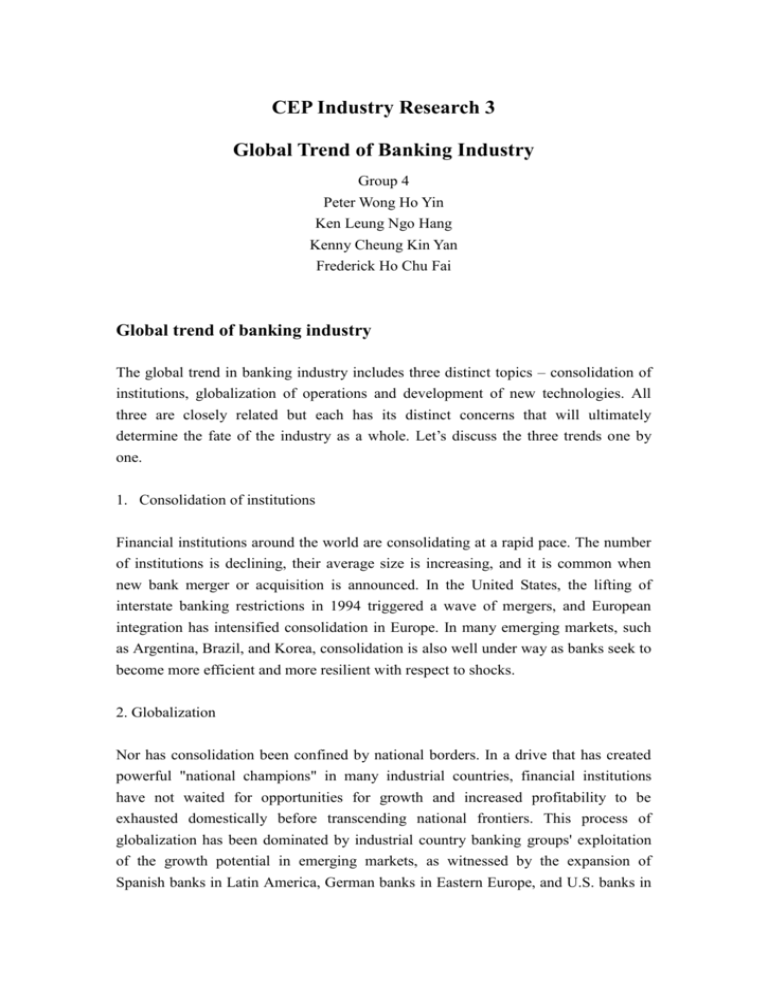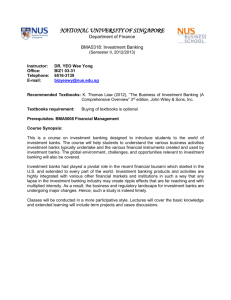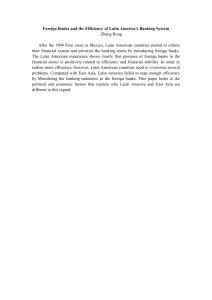Increasing competition between investment bank & commercial bank
advertisement

CEP Industry Research 3 Global Trend of Banking Industry Group 4 Peter Wong Ho Yin Ken Leung Ngo Hang Kenny Cheung Kin Yan Frederick Ho Chu Fai Global trend of banking industry The global trend in banking industry includes three distinct topics – consolidation of institutions, globalization of operations and development of new technologies. All three are closely related but each has its distinct concerns that will ultimately determine the fate of the industry as a whole. Let’s discuss the three trends one by one. 1. Consolidation of institutions Financial institutions around the world are consolidating at a rapid pace. The number of institutions is declining, their average size is increasing, and it is common when new bank merger or acquisition is announced. In the United States, the lifting of interstate banking restrictions in 1994 triggered a wave of mergers, and European integration has intensified consolidation in Europe. In many emerging markets, such as Argentina, Brazil, and Korea, consolidation is also well under way as banks seek to become more efficient and more resilient with respect to shocks. 2. Globalization Nor has consolidation been confined by national borders. In a drive that has created powerful "national champions" in many industrial countries, financial institutions have not waited for opportunities for growth and increased profitability to be exhausted domestically before transcending national frontiers. This process of globalization has been dominated by industrial country banking groups' exploitation of the growth potential in emerging markets, as witnessed by the expansion of Spanish banks in Latin America, German banks in Eastern Europe, and U.S. banks in East Asia. At a somewhat slower pace, cross-border consolidation is also taking place between industrial countries, initially in the form of strategic alliances that offer some of the benefits of diversification without the costs of merging different business cultures. 3. Development of New Technology Developments in technology, and especially the impressive growth of Internet banking and brokerage services, have allowed globalization to go beyond the ownership structure of financial conglomerates and to reach the retail markets. In fact, many banks are using their online operations to expand into foreign markets, avoiding the costly process of building retail brick-and-mortar networks of branches. Moreover, the emergence of alliances between major banks and telecommunications conglomerates suggests that, in the future, competition in the electronic marketplace will be fierce. In addition, the appearance of virtual banks and the development of electronic money for the global Internet market have created the possibility for the growth of nonbank (and, possibly, largely unregulated) institutions that provide credit to, and collect funds from, the public. Faster communications require faster reactions from both markets and policymakers but also quickly make information obsolete. Increasing competition between investment bank & commercial bank In the past, the two kinds of banks were doing their businesses separately. Investment banks were mainly focusing on institutional or high-end investors while commercial banks were mainly dealing with personal banking services. However, these days, the competition between investment banks and commercial banks is becoming increasingly keen. There is a trend that the commercial banks are beginning to start the businesses that were previously dominated by the investment banks, including investment banking, trading & principal investment and asset management. We are going to show some of the statistics to support that investment banks have been given a bit hit by the commercial banks in some aspects. We have chosen Goldman Sachs as an example of investment banks while Bank of America as an example of commercial banks. The reasons of choosing these two corporations are that they are good representatives of the respective kinds of banks and they can show the increasing competition between them. Investment bank – profitability Fig. 1 below shows the profitability of Goldman Sachs in last three years. For an investment bank like Goldman Sachs, the major profit-making activities include investment banking, trading & principal investments and asset management & securities. We can notice that the total revenue has been decreasing for three consecutive years, from $16590 in year 2000 to $15811 in year 2001 to $13986 in year 2002. Fig. 1 Revenue ($ in millions) 2002 I. Investment banking 2001 2000 $3836 (↓29%) 6349 $5371 II. Trading and principal investments $2830 (↓26%) 5249 III. Asset management and securities services Total 5907 (↑5%) $13986 5626 (↑18%) $15811 4592 (↓12%) (↓5%) 6627 $16590 If we look in more detail, we can notice that the business of investment banking suffered a major setback in the two recent years. Fig. 2 shows the categories under investment banking, including financial advisory and underwriting. Both of these recorded a large drop with more than 20% drop for each year. Fig. 2 Revenue (millions) 2002 2001 2000 Financial Advisory $1499 (↓28%) $2070 (↓20%) $2592 Underwriting 1331 (↓25%) 1766 (↓36%) 2779 Total $2830 (↓26%) $3836 (↓29%) $5371 On the other hand, asset management & securities is the only major business that Goldman Sachs was doing well in the two previous years. We can notice that this part has recorded a fast growth, especially in the categories of asset management and commissions.(Fig. 3) Fig. 3 Revenue (millions) 2002 2001 2000 Asset Management $1653 (↑12%) $1473 (↑10%) $1345 Securities Services 981 (↓13%) 1133 (↑21%) 940 Commissions 3273 (↑8%) 3020 (↑31%) 2307 Total $5907 (↑5%) $5626 (↑18%) $4592 Commercial bank – profitability As we have mentioned, many commercial banks have been aggressively expanding their businesses in the field that was mainly done by investment banks. In other to make a more fair comparison, we have chosen the businesses of a commercial bank – Bank of America – that are similar to that of investment banks. Fig. 4 shows the income from investment banking part of Bank of America. Although it also recorded a drop in income in year 2002 compared with year 2001, the drop was only 3%. If we compare this amount with that of Goldman Sachs, we can notice that the corresponding drop of Bank of America is much smaller. What does this imply? There is a high chance that the expand of business of commercial banks has captured some of the markets that lead to the large drop in revenue in the investment banking part. We believe that the wide base of customers of commercial banks is a very significant factor leading to easy access of securities underwriting and advisory services. Fig. 4 Income ($ in millions) 2002 2001 Securities underwriting $721 (↓9%) $796 Syndications 427 (↑8%) 395 Advisory services 288 (↑15%) 251 Other 45 (↓46%) 84 Total $1481 (↓3%) $1526 On the other hand, Bank of America recorded a little drop in income in the asset management part.(Fig. 5) If we compare the similar business of investment bank Goldman Sachs, we can notice that Goldman Sachs was doing much better in this part. We believe that the reason for this is mainly because that the professionals in investment banks are more superior than that in commercial banks in the field of asset management. Fig. 5 Income (millions) 2002 2001 Asset management fees $1087 (↓4%) $1129 Brokerage income 435 (↓3%) 450 Total $1522 (↓3%) 1579 The prospect of Banking Industry We expect that the future banking industry will be more and more complicated. However, the four fundamental trends would be retaining as there is the only way for banking industry to survive. In short, the banking sector is entering a new world in which national and institutional boundaries are becoming less important. Inevitably, supervisory and regulatory systems will have to adapt their work methods in order to remain effective. The growing emphasis on risk management, exchange of information, and coordination at the international level is evidence of efforts to adapt. Nevertheless, some questions, such as the specific measures to be taken for banks in difficulty, are not easily answered. Adapting regulatory and supervisory frameworks to rapidly changing financial markets will remain a daunting challenge and will require further cooperation between supervisors, markets, and individual market participants.








